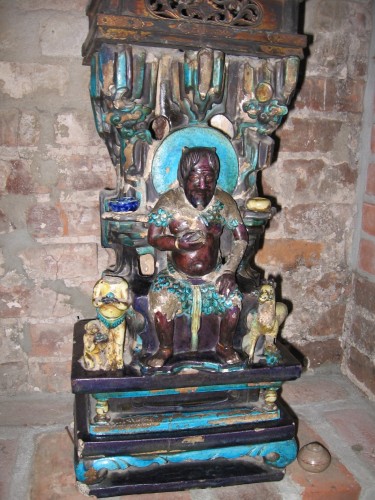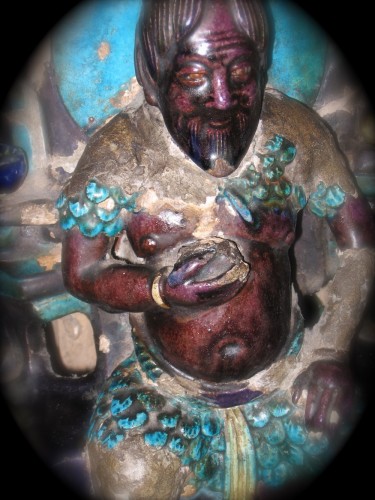My esteemed China-scholar sister Charlotte Furth solved the question I asked last year. Who is this wildman, who currently lives in an empty fireplace in our bedroom? We know how he got into our possession – a purchase by our grandparents, when Asian artifacts were routinely pried from their places of origin in ways that -thankfully- horrify us today.

Charlotte said he is a god of agriculture, Shennong, and then referred to one of her colleagues, Susan Naquin at Princeton. Who replied:
You are right. This is Shennong 神農. First agriculturalist, culture hero, associated with medicine, known in pre-Han texts. Absolutely Chinese. I’m less clear about the history of the iconography, and most of the stuff I turned up on medicine on the web is very recent and unrestrainedly imaginative. Be careful.
The statue in question is of a type familiar to me from the late Ming or early Qing, north China, I would call this one relatively unusual and nice, but to most art historians this kind of regional ceramic showing a popular god is not a high-status or high-value item.
This “leaf” outfit is common for Shen-nong as a god…I have seen many similar objects showing instead the god Zhen-wu 真武, or Guan-yin 觀 probably Shanxi province. In the auction-market world, this format (god, seated enclosed in a kind of grotto) and these materials (琉璃瓦 lead-glazed ceramic, in turquoise, cream, aubergine)(alternate palate: green, cream, yellow) are well known. Some were indeed “architectural” and used on the outsides of pagodas, but I believe yours was intended as a free-standing altar with figure. Halos are common in this format. I presume it is perhaps one foot high? [*YES]
A proper study of the iconography needs doing. What is he holding? At some point Shen-nong holds a yin- yang symbol, perhaps here.
音. Let me see if I can find some comparables, but my best examples are on my othercomputer. The printed-book British Museum catalogue of their ceramics edited by Jessica Harrison-Hall might be your best scholarly reference: J. Harrison-Hall, Ming Ceramics – A Catalogue of the late Yuan and Ming Ceramics in the British Museum (London, British Museum Press, 2001), esp. chapter 13, 18, 19. Though there is nothing exactly the same.
Withal, he’s just fine in our fireplace. A friend made a small bowl for his periodic tot of gin — and there he presides. Thank you, Charlotte and Susan.

